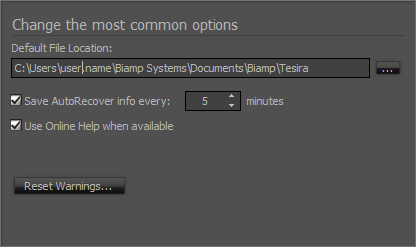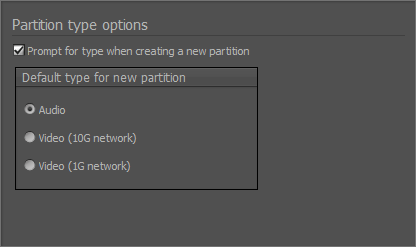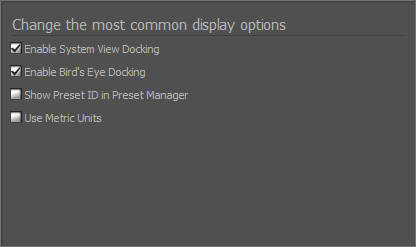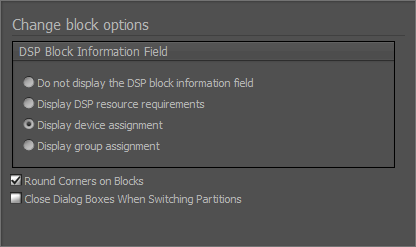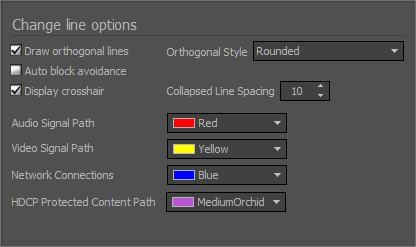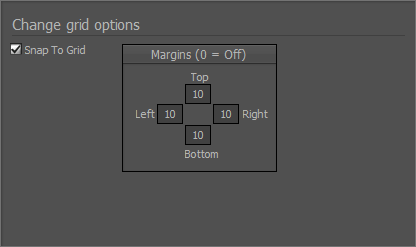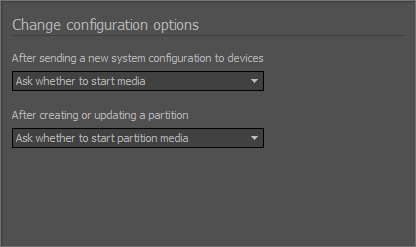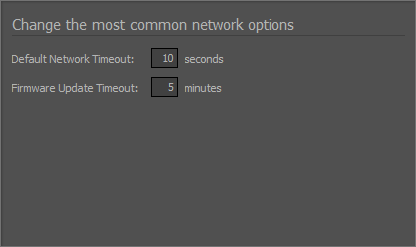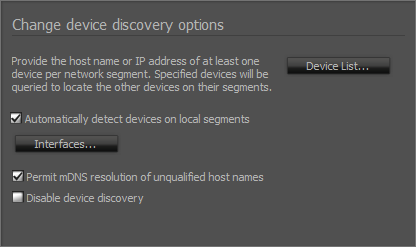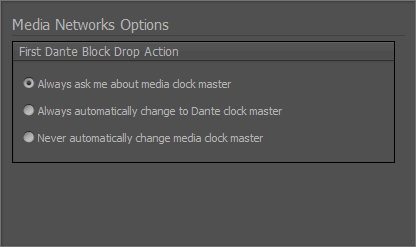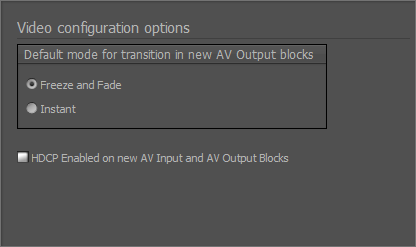Options
Global settings are subdivided into two categories: Application Settings and Document Settings.
Application Settings
Determines many base display and configuration options of the Tesira Application. There are several options within the Applications Settings dialog General, Display, Compile, Configuration and Network.
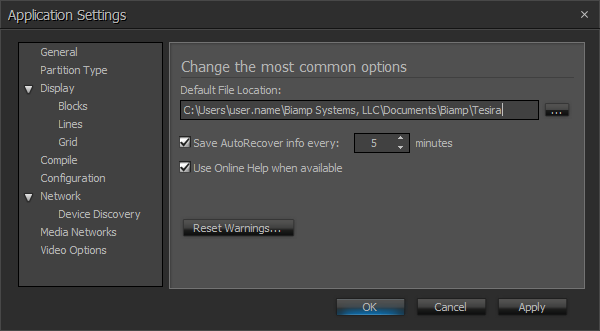
General Options
Allows Data Files (system designs) and Processing Libraries (Component Objects) to be saved to specified directory locations. Allows the Save AutoRecover time to be adjusted or disabled. Reset Warnings will let any suppressed warnings to be reset.
'Use Online Help when available' gives the user the option to access the latest web-based version of the Tesira help file when clicking the  icon in Tesira. If unchecked, Tesira will open the software-embedded help file.
icon in Tesira. If unchecked, Tesira will open the software-embedded help file.
The option to access the online version of help was introduced in Tesira v 3.13, but users will be directed to the most recent release of the help file when this option is checked (default), regardless of the software version they are currently running. The online help may reflect a later version of the software than currently being used. Be sure to review the release notes to check for any features that may not apply to your version of the software. Software may be updated at support.biamp.com.
Partition Type
Is used to specify the default type for new partitions, and whether the user is prompted for this selection every time a new file is created.
Display Options
The general display options allows docking to be enabled for the System View and Bird’s Eye View sheets. Show Preset ID in Preset Manager inserts a column in the Preset Manager view sheet where the preset ID number is always displayed.
Block Options
This selects the details to be displayed on the DSP blocks in the layout. The options are as follows:
- Do not display the DSP block information field – display nothing on the DSP blocks.
- Display DSP resource requirements – display DSP resources for a block in percent.
- Display device assignment – display the hardware unit in which this DSP object resides.
- Display group assignment – display the DSP group in which this DSP object resides.
- Round corners on Blocks is a cosmetic feature.
- Close Dialog Boxes When Switching Partitions will close all open dialogs (i.e. DSP block control dialogs) when another partition becomes the active view.
Line Options
Allows the line drawing options to be configured.
- Draw orthogonal lines automatically bends lines at right angles to meet DSP block nodes. The style can be normal (right angles at turns), rounded (no right angles at turns) and rounded with jump-overs (lines jump over existing lines).
- Enabling of Auto block avoidance automatically turns lines around DSP blocks in the layout.
- Enabling of Display crosshair will use the crosshair rather than the hand pointer to draw the lines.
- Collapsed Line Spacing determines the horizontal separation of vertical lines in Orthogonal line drawing mode when the left arrow key is held.
- Any color can be chosen for the signal path (using the signal path identifier) and Network Connections.
Grid Options
Enables the snap to grid functionality on placement of DSP blocks and lines. Margins can be chosen for blocks in the layout window (pixels).
Compile Options
Determines how the Application handles hardware allocations during the compilation process. Add Devices allows the compiler to add Tesira hardware to the system equipment table and allocate DSP blocks to the new unit(s). Use discontinued devices will allow discontinued devices to be selectable from component objects as well as show up during compilation. Discontinued devices will also be selectable from the equipment table when assigning a physical device.
Configuration Options
Determine how the system prompts the user when one or more audio partitions are updated. The options can be set to prompt the user to start audio, automatically start audio or do not start audio.
Network Options
Sets the timeouts for network control communications and firmware updates.
Device Discovery Options
Configures the way the Tesira application finds hardware on the network. Automatic discovery allows the application to automatically detect Tesira hardware on the local area network. Multiple Network Interface Cards can be chosen to detect Tesira hardware on multiple LAN's.
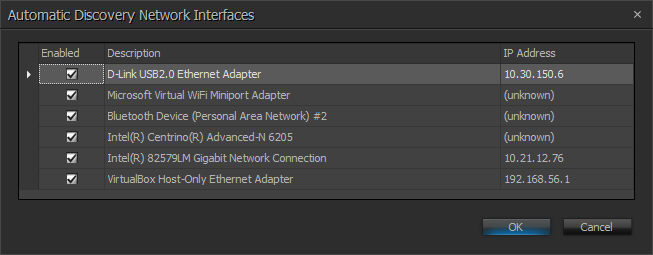
In the case that one Network Interface Card (NIC) is discovering Tesira units on a routed network, hostnames or IP address can be manually entered in the Device List for discovery.

The Discovery Device List dialog allows users to manually enter hostnames or IP Addresses of devices to be searched for during device discovery. When adding to the list, 'Enabled' is checked by default. The Description field is optional.
Data may be exported or imported to or from a .csv file. Upon import, any duplicate IP Addresses will be retained in the Discovery Device List. Default location for import/export is C:\Users\<username>\Documents\Biamp\Tesira\DataFiles.
Permission of mDNS allows software resolve hostnames using the multicast DNS protocol, which requires no DNS server. Disabling device discovery defeats all previous options in this section.
Media Networks
Media Networks allows for clock master defaults to be set when Dante blocks are added.
Video Options
The Video Options allows the default mode for transitions when new AV Output blocks are added. Options available are Freeze and Fade or Instant.
